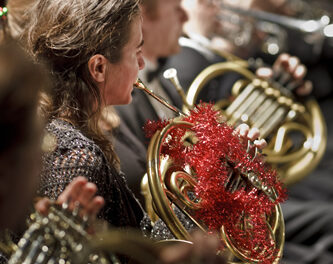Somehow an overflow audience for the August 27 concert of the Four Seasons Chamber Music Festival August 27 was shoehorned into Fletcher Recital Hall. If this season’s turnout holds at that level, presenters will need to give two performances or find a venue with double the seating capacity. Each concert is part of a weeklong residency that involves masterclasses, special public school programs, and open rehearsals. Musicians are housed, fed, and ferried about by community supporters.
During the course of the program, Artistic Director Ara Gregorian played viola and violin – in the first and second positions. He was joined by some of the finest talents available today – violinist Jennifer Frautschi (http://www.jenniferfrautschi.com/ [inactive 10/05]), violist Nicholas Cords, cellist Sophie Shao (http://www.sophieshao.com/ [inactive 10/04]), and Eric Ruske, horn.
Mozart’s Horn Quintet in E-flat is a horn concerto in all but name. The horn is featured as a soloist throughout, and some of the score’s demands exceed those of the four well-known horn concerti. There are plenty of rapid passages, an extended range from high C down to low G, and frequent wide leaps. There are humorous exchanges between the violin and horn – the dedicatee, Joseph Leutgeb, was often the butt of the Mozart’s heavy-handed humor. The string complement – violin, two violas and cello – provides the horn a framework permitting great tonal warmth. Ruske’s playing was nothing less than spectacular: unbelievably fast runs were articulated with absolute clarity, and the big leaps (upward in the slow movement, down in the last) were on the money. His trills were a delight, as were his long-held notes. Frautschi’s intonation was superb, and her phrasing was strongly characterized. Her 1722 Antonio Stradivarius, known as the “ex-Cadiz,” has a marvelous tone and fine timbre. Gregorian and Cords produced rich viola sound complemented by Shao’s unusually sensitive cello playing.
For an unannounced “surprise,” Ruske was joined by pianist Paul Tardiff for Vittorio Monti’s “Csárdás.” This showpiece, featuring a languid slow portion followed by a fiery one, had to be seen and heard to be believed. Ruske did things with a horn I would have never believed possible.
Dvorák’s String Quartet No. 10, in E-flat, Op. 51, is rarely performed – I heard it twice in the 1980s but cannot recall a recent performance (although it will figure in a Miró Quartet concert in Raleigh on September 12). In 1878, with a series of works including the first set of Slavonic Dances, the composer found his own voice. In my favorite crib, Guide to Chamber Music , Melvin Berger describes this self-discovery as “capturing the directness, warmth, simplicity, and infectious merriment of native Czech folk music, without resorting to overt borrowing of national melodies.” The first movement is extraordinarily light in both mood and texture. There is a hint of the polka in the radiant first theme that carries over into the second theme. The second movement is a wonderful dumka. Over gentle pizzicato chords in the cello, echoed by the viola, the first violin sings a sad lament, followed by a fast furiant-like interlude. The short, song-like third movement is followed by a breezy and exuberant finale based on the skacna, a boisterous Bohemian reel dance. Frautschi played first violin and Gregorian, second. The four artists wove a chimerical sonic tapestry in the first movement – I cannot imagine its will-o’-the wisp quality being better captured. Shao produced pizzicatos of rare delicacy throughout. Frautschi’s second movement lament was breathtaking. The third movement was memorable for its perfectly matched violin duet, set over low string harmonics. Everyone radiated the pure joy of making music in the last movement.
In contrast to Op. 51, Dvorák’s String Quartet in F, Op. 96 (“American”), seems to appear on at least one series in every season. Since it is played so often, it is almost impossible for regular touring quartets to keep it fresh. (A local cellist, only half joking, once said that the only way to do it was to play these quartets without rehearsal.) Gregorian led this performance. While the perfection of the intonation and the tight ensemble bespoke careful rehearsal, the “newly-minted” quality of the ensemble’s playing reflected the benefits of an intense residency, as opposed to a long tour. This concert set the quality bar very high, indeed, not just for future concerts in the series but as a standard for others, too.












